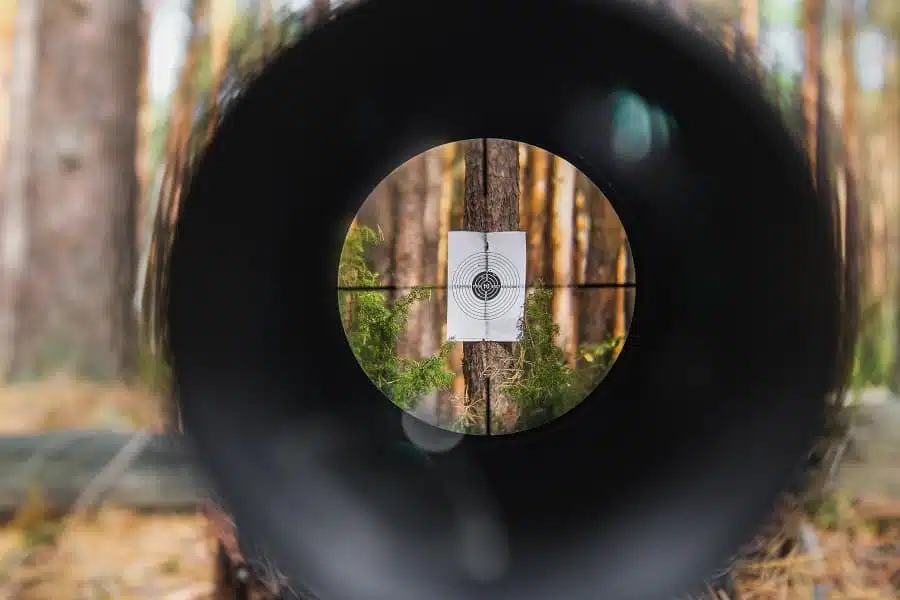We all know the buzz after getting our first scope. However, we also remember the dread that setting up your scope is. For most beginners, learning how to zero your rifle scope properly will be difficult. That’s because there will be a lot of factors at play when setting things right for the first time.
The good news is, though, that after learning how to do this, it will get much easier and you will become far more accurate at different distances. That’s especially important for hunting when your target won’t be at the same pre-set distance every time and you will have to adjust on the go.
In this article, we will go through some of the basics of “setting your zero” or zeroing in your scope. The most important parts are:
- Learning the basics
- Choosing a target
- Choosing a distance
- Understanding Windage and Elevation
- Setting up your rifle and scope
For some of the best scopes for 308 rifles, click here to read my Full Buyer’s Guide. Now, let’s jump straight into this!
Learning the basics
Since we’re talking about the basics of scope zeroing, I am going to assume that you’re a beginner shooter. That being said, there are a few terms that you should know moving forward. The first ones are:
- Point of impact (POI) and Point of aim (POA)
These two are pretty self-explanatory. Your point of aim is where the reticle of your scope is positioned on the target. Your point of impact is the actual hole the bullet makes through the target.
- MIL vs MOA
While this subject requires a separate article dedicated to it, the shortest explanation is that you will benefit more from using MOA (minutes of action) for short-distance shooting and hunting rather than using milliradians (MILs). Both are angular measurements and both have little to no effect on scope zeroing. In short, 1 MOA adjustment will move your reticle horizontally or vertically by 1 inch at a distance of 100 yards. In order to fine-tune your scope, most models will divide each click or each MOA into 4 smaller quarter clicks.
- Scope turrets
These are typically located in the middle of your scope and are two – one for the elevation of your reticle, and the other for the windage. They can be closed turrets with the rotating part inside or can rotate freely without having caps. Some turrets can be adjusted with your bare hands, while others need tools to be adjusted. Some scopes have an extra turret that is for the magnification of the scope.
- Grouping
Most people call a “group” three shots that are fired one after another and fall within a close distance of each other. You will use these groupings to determine a rough average POI (point of impact) to adjust towards.
Two very important terms you should also understand are the windage and elevation of your scope. However, I will dedicate a whole chapter to them in a moment. Now, let’s talk about your target…
Choosing a target
If you’re setting up your scope the traditional way (more on the non-traditional in a bit), you should pick a target. My advice is to go to a range of zero in your scope since ranges usually have well-measured and predetermined distances to different targets. That will allow you to not only accurately set your scope but also learn how to adjust it for various distances. It will also give you a bit more insight into your bullet trajectory at different distances.
Moreover, shooting ranges will give you additional benefits such as rifle rests, a table to shoot from, or a tripod. All these things are crucial for a successful zeroing of your scope, as stability is paramount to consistent shots.
The target can be anything you can clearly see the bullet holes on. The normal black-on-white target that most ranges use is usually good enough.
Choosing a distance
The typical distance most hunters zero in their scopes is 100 yards. That is usually roughly the average distance you will have to your target out in the wild. Additionally, most manufacturers list their bullet drop rates at the back of each box of bullets, so make sure you account for that as well. Note that their measurements won’t be the same as yours since the chances of you two using the same rifle are quite low.
You can also use the bullet drop rates to calculate what your drop will be at further distances such as 200 and 300 yards. That way you will know how much drop compensation to use. If you’re using a smaller caliber rifle, I suggest picking a shorter distance such as 50 yards at first. Even 25 yards will be good enough for starters if you want to save some time and bullets.
Understanding Windage and Elevation
One of the most important parts of the setting up process is actually knowing how to adjust the scope. We adjust rifle scopes by changing a few things – magnification, windage, and elevation. Since magnification doesn’t play a crucial role in accuracy, we will be focusing on windage and elevation only.
Most scopes have two knobs (or dials) you can turn in order to adjust the windage and elevation. These are called “turrets” and can be turned either by hand or by a special instrument, depending on the model you have.
Now, what do windage and elevation actually mean? Well, you can think of the windage of your scope as the horizontal adjustment of the reticle. Or, in even simpler terms, if you want to move your reticle right or left on the target, you adjust your windage in either direction of the dial. Contrary to that, the scope’s elevation moves your reticle up and down the target.
With that in mind, you should know that each dial rotates in clicks. Each click typically represents a quarter of a MOA (minute of action). As I mentioned earlier, one change of one minute of action is an inch in either direction at 100 yards. Scopes usually have their MOAs divided into quarters for each click. So, to sum up, each click on your windage or elevation dial is 1/4 MOA, meaning 1/4 inch change at 100 yards. That way it allows for much finer tuning of the scope.
Important Note: The MOA adjustments extend into other distances geometrically. That means that 1 MOA is 1 inch at 100 yards and 5 inches at 500 yards.
Setting up your rifle and scope
Now that we’ve gone through everything you need to know and do before actually setting up the scope, let’s get started with the set-up process itself!
After you’ve set up your rifle sturdily on a rest or a table, fire a few shots. These first few shots should be your first point of impact and you will adjust according to them. If your second shot falls within the first, there won’t be a need for more follow-up shots to finish the grouping. The whole goal of the zeroing is to follow your initial point of impact with the reticle. For example, if your bullet impacts are to the right of the center you should aim your reticle towards the right and make it fall within the holes of the bullets.
Let’s use an example to make things a bit easier!
Example of a Set-up Process
Let’s say we are aiming at 100 yards for ease of use of the MOA scale. We aim dead center of the target and miss our shot by 3 inches to the right and 5 inches down. What do we do?
Well, since we know that 1 MOA is 1 inch at 100 yards, we should adjust 3 MOA to the right (windage) and 5 MOA down (elevation). And since our scope’s dials have each click at 1/4 MOA, it means that we need to do the following:
- Adjust 3 x 4 clicks (3 MOA x 4 clicks, each being 1/4 MOA) to the right, turning the windage dial
- Adjust 5 x 4 clicks (5 MOA x 4 clicks, each being 1/4 MOA) down, turning the elevation dial
After we’ve done that, the reticle should be pointing straight at out first bullet holes, or at least very close to them. Remember that our rifle is stationary, so any changes we make to the scope should move the reticle only.
Next, aim at the center of your target again and fire another group of shots. Repeat the same process until you zero in your scope perfectly at the said distance.
You can do that for every distance you choose. This will give you a better understanding or your bullet trajectory, even if the bullet manufacturer has listed it on the box. That way, you will be able to quickly adjust when out hunting and your targets appear at different distances.
After you’ve successfully zeroed in your scope, remember that you will have to maintain your zeroing over time. That means that you will have to periodically check if your scope is still that accurate at the distances you’ve tested it. In my experience, you should recalibrate your scope every few months in order to make sure it’s accurate. Also, it goes without saying, but if you use the scope on another rifle and/or with other ammunition, you should repeat the whole zeroing process from the beginning.
How To Zero A Night Vision Scope
Night vision scopes can be a bit easier to zero in based on the model you bought. Some higher-end models even have an automatic zeroing feature that will find and adjust the reticle of the scope based on your bullet holes. And while that doesn’t always work as advertised, it is a cool feature to have, especially if you find it hard to zero the scope yourself.
What’s better, some models have automatic zeroing modes that work with your scope’s built-in rangefinder to figure out the distance to the target and adjust the reticle accordingly.
Apart from all that, night vision scopes are pretty straightforward and almost identical to normal scopes when it comes to setting them up. However, for most models, you will have to keep the lens cover on. The reason for that is that you risk damaging the scope unless you keep the cap on during the day. Most scopes will have a tiny pinhole in the middle of the lens cover. That pinhole will let just enough light in for the scope to function properly without damaging its sensitive sensors.
If you also want to learn how to sight in a compound bow, make sure you read my detailed article on that topic here!
FAQ
How to set up a scope for 200 yards when only having 100 yards to work with?
To do that you will need to see the specifications of the bullet at the back of the bullet box. If these bullets are 5 inches high at 100 yards, you should zero in your reticle at 5 inches above the bullseye. That way, your groupings will be 5 inches above the center at 100 yards but dead center at 200 yards. This will allow you to be better prepared for longer shots but also to know how to compensate at 100 yards and further distances than 200 yards without missing by too much.
Are mechanical bore sighters accurate?
As far as accuracy goes, mechanical bore sighters aren’t terrible but aren’t great either. They can do a good job at close range, around 20-40 yards. Go further from that, however, and you will find that they quickly become inadequate at best.
How to prepare my rifle for zeroing?
The most important preparation you need to do for your rifle is to make sure its bore is dry and clean. The best way to do that is to either run an oil patch through it or fire a few shots through it before you start zeroing. Also, make sure you give your rifle some time between shots to keep the barrel from overheating. In the shooting field, this is often referred to as a “cold bore zero“, while all the other shots might widen your grouping and, therefore, make zeroing your scope harder.
What are the things to avoid when sighting your rifle?
One common mistake I suggest beginners avoid is to start zeroing at 100 yards. You will save a lot of time (and bullets) if you start zeroing in your rifle at 25 yards. Then, after sighting it in at that distance, you can move to 50, 75, and finally 100 yards.
Another mistake, at least according to me, is wasting your time and money on laser bore sights. These might work in some cases but aren’t practical enough for me to recommend them to a beginner.
Conclusion
In short, learning how to zero your rifle scope properly is going to be one of the more technical processes in the beginning. However, as you master that skill, you will learn how to compensate for bullet drops better and understand distances better. Moreover, the more you train with your scope at a range, the more you will understand how different conditions and the weather affect your bullet trajectories. With all that knowledge gathered, you will be far more successful when out hunting!



